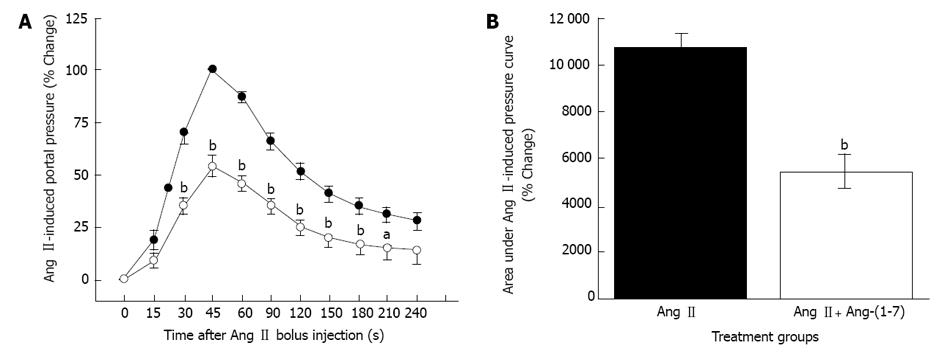Copyright
©2013 Baishideng Publishing Group Co.
World J Gastrointest Pathophysiol. Feb 15, 2013; 4(1): 1-11
Published online Feb 15, 2013. doi: 10.4291/wjgp.v4.i1.1
Published online Feb 15, 2013. doi: 10.4291/wjgp.v4.i1.1
Figure 3 Angiotensin-(1-7)-induced portal pressure reduction.
Portal pressure changes in response to angiotensin II (Ang II) in cirrhotic rat liver. Portal pressure responses were measured using a vertically positioned graduated fluid-filled column open to atmospheric pressure. Ang II bolus (60 pmole) was injected into the portal vein of in-situ perfused cirrhotic rat liver preparations in the presence of an angiotensin converting enzyme (ACE) inhibitor lisinopril (0.7 μmol/L). A: Percentage increases in pressure in response to Ang II bolus in the absence (closed circles) or presence (open circles) of angiotensin-(1-7) [Ang-(1-7), 0.7 μmol/L]. The highest pressure that was recorded 45 s after the Ang II bolus injection was designated as 100% response and all other responses were calculated relative to this maximal reponse. B: The total area under Ang II response curve (AUC) in the absence (filled bar) or presence (open bar) of Ang-(1-7). Portal pressure change at each time point in panel A and AUC in B represents the mean ± SEM from 21 cirrhotic rat liver preparations. Pre-incubation with Ang-(1-7) significantly reduced the portal pressure response evoked by Ang II bolus injection. aP < 0.05, bP < 0.01 vs those with Ang II alone.
- Citation: Herath CB, Grace JA, Angus PW. Therapeutic potential of targeting the renin angiotensin system in portal hypertension. World J Gastrointest Pathophysiol 2013; 4(1): 1-11
- URL: https://www.wjgnet.com/2150-5330/full/v4/i1/1.htm
- DOI: https://dx.doi.org/10.4291/wjgp.v4.i1.1









